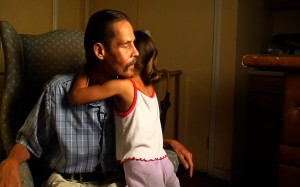This post originally appeared on CNN.com on Monday, June 21, 2010.
He didn’t look like much when I first saw him strolling up to me at a campsite in Harriman State Park, exactly two years ago. His hair was stringy and unkempt, his thin face unshaven. A smudged shirt and dirt-covered pants hung from his wiry, 50-year-old frame.
I was leaving the communal bathroom, having just plugged my drained cell phone into the outlet by the sink, when I saw him approaching. He nodded warmly as we passed and I found myself suddenly wondering if I had just seen the last of my phone….
Moments later, he reappeared. When he saw me again, he said with incredible glee, “Isn’t this the most beautiful morning?” I nodded and then went back into the bathroom to find my cell phone right where I left it. Needless to say, I felt more than a little guilty about being so judgmental.
And that’s the story of how I met Ralph Benitez, the man who would eventually become the heart of my fatherhood documentary, The Evolution of Dad.
A short time after our initial encounter, I was washing some silverware at the communal sink and Ralph appeared with his own dishes. As we scrubbed, he told me how his sons had brought him on this camping trip and how lucky he felt to be with them.
“You know, fatherhood saved my life. It did. I wouldn’t be alive now if I hadn’t become a dad,” he confessed, explaining that before fatherhood his life had been all about “sex, drugs and rock-‘n-roll.”
As we finished the dishes, Ralph regaled me with stories about his kids. He told me that one of his sons is gay and how, despite his cultural background, he accepted his son unconditionally. He told me about his 4-year-old granddaughter, for whom he was now a surrogate dad. I was startled and a little chastened. Here was this guy, who, minutes earlier, I had worried would steal my phone, and who I now realized completely personified everything that was noble about fatherhood.
I would never have met Ralph had I not gone camping that weekend. He lived in the Bronx with his family, but it might just as well have been the moon. Ralph didn’t have a computer. Sometimes he didn’t even have phone service. There was a great divide between this man from an inner city Latino community and me, a white Jewish guy from the affluent suburbs. But the differences in our backgrounds dissolved as we quickly forged a friendship. Soon after our first meeting, I visited his home in the Bronx where he, his wonderful wife, Vilma, and the rest of their family welcomed me with great warmth.
I visited Ralph and his family several times that summer, filming as much as I could of this dad who spoke for so many fathers. Witnessing Ralph with his granddaughter, Kayla, as he lovingly took her to the park or for a stroll to the corner deli, was inspiring. Kayla’s biological father wasn’t in the picture and Ralph had dutifully stepped into the role. And then there were the kids in the neighborhood who all looked up to him, many lacking dads of their own. Ralph called his two-bedroom apartment “the safe house” because, in this particularly tough area of the Bronx, it was a place that friends and family and neighborhood kids could come and always feel secure.
For Ralph, the world was a horn of plenty. “You see?” he would often say to his wife, “If you have faith, God will provide.” Vilma, always the anchor to his exuberance, would roll her eyes with a “Yeah, yeah, yeah,” and although they occasionally squabbled, the love they shared with each other and everyone else in this safe haven was always tangible. If wealth could be only measured in love, then Bill Gates would’ve had nothing on Ralph.
Sadly, there was a sense of urgency to film Ralph as quickly as possible because his health was rapidly deteriorating – Ralph had full-blown AIDS. Miraculously, he had managed to survive for over ten years with the virus because he had volunteered himself as a test subject for any of the experimental drugs that Sloan Kettering was trying. He was even among the first to take “the cocktail.” As we sat together in his driveway one day, he told me that the doctors had recently told him that his medicine was becoming increasingly less effective and there was nothing more to do.
Still, we continued to spend time together and Ralph remained upbeat and hopeful. One of my best memories of Ralph occurred while taking a break from shooting, sitting with him in his driveway. In the heat radiating from the pavement, we ate plantains that Vilma had graciously cooked for us and talked about what was going on in the world, about our families, about anything. It was like we had known each other our whole lives.
As the summer slid away, so did Ralph’s health. His family became less interested in being filmed, and Ralph explained that they were having a hard time coping with the fact that he wouldn’t be around much longer. Honestly, it was hard for me to imagine a world without him as well.
“Dana, fatherhood is important,” he kept repeating to me, like a mantra, as I sat next to his hospital bed. “People need to know that. You must finish the film, so that people can really know this.” I promised him I would.
Ralph Benitez passed away one snowy day in December of that year. I got the call one morning as I was getting my kids ready to go sledding. Even though his passing wasn’t a shock, it took a while for me to get over it. I’d never had a film subject die before, let alone a friend. I gave his family all of the footage I had filmed of him, wishing it could make a difference, but of course it wouldn’t bring Ralph back.
Ralph agreed to be in the film because he wanted to be remembered and because of how important he understood fatherhood to be in the lives of our kids. I wish he could’ve seen the finished film. But even though he didn’t, I think he felt lucky to know that a part of him would live on in this way. For me, I just felt incredibly blessed to have met such an astonishingly wonderful man and a remarkable dad.
Rest in peace, Ralph. Your memory lives on.







Sorry, comments are closed for this post.